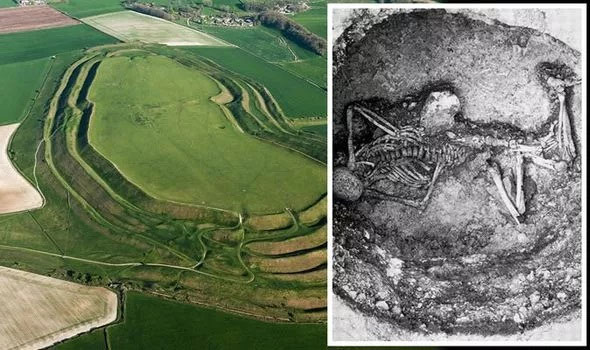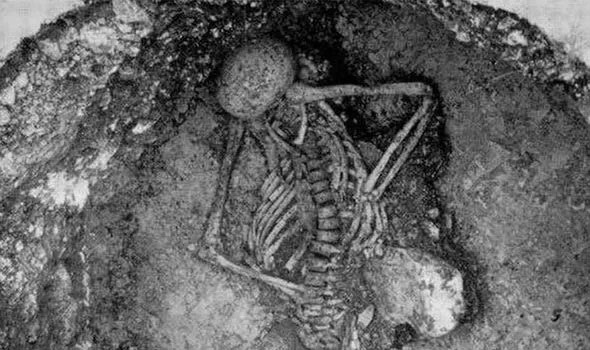The creepy mystery of the Iron Age skeleton buried in a strange position in the ancient castle
Researchers were stunned to discover an Iron Age skeleton buried in a sitting position at the ruins of Maiden Castle in the United Kingdom. They consider this to be evidence of a brutal sacrifice.
Maiden was one of the largest and most elaborate castles of the Iron Age in Europe.

The skeleton was found buried in a strange position.
The size of this castle is equivalent to the size of 50 football fields. It is home to many giant ramparts, most of which were built in the first century BC, once defended by hundreds of inhabitants. When it was first built, these ramparts stood tall in the midst of the surrounding landscape.
Excavations have been going on in the area for many years and have yielded many important results about the history of England.
Among them are a Neolithic fence from around 3,500 BC and a Roman temple built in the 4th century AD.
Archaeologists have also found evidence of a late Iron Age cemetery where many of those buried suffered horrific injuries.
One of the bodies found at burial sites of interest to researchers was featured in the 2020 Smithsonian Channel documentary, "The Mystic British".

The skeleton buried in an upright sitting position is known as the "mystical Englishman".
According to Professor Neil Sharples, an archaeologist at Cardiff University, who has spent decades investigating Iron Age hill fortresses.
More than 80 years ago, a body was dug up from this fort and, as the documentary's narrator Clive Anderson notes, "there was something very unusual about the burial" about this body.
"At the bottom of this hole there is a grave of a young man, maybe 20 to 30 years old and he looks like he is sitting at the bottom of this hole," Professor Sharples said.
Most of the recorded Iron Age burials were placed in the fetal position or crouched, not sitting upright, but the young man's body was different.
In addition to that unusual burial position, Professor Sharples believes the body's position is also "very important".
"Around 350 BC, they decided to expand and make Maiden Castle the largest hill fortress in the region. But there was a huge ditch right in front of it that looked like flat land today but that's it. actually a 6m deep, v-shaped ditch. The ditch was then filled in, and they built a new rampart."
The new citadel is the place where the young man's body is buried.
"Clearly this was a deliberate sacrifice to mark this additional construction - to expand the fortress on the hill," Mr. Sharples explained of the hypothesis that the young man had been sacrificed.
- Discovered a 3,500-year-old male and female skeleton in the fist position
- Difficult mystery story in Edinburgh castle
- The second 'ghost' photo at the ancient castle in Scotland
- The newly discovered skeleton in Caistor made archaeologists confused
- Discovering bones' 2,000-year-old ancient vampire in England
- The castles are deserted with beauty
- Goose bumps with iron-legged animals with iron armor
- Discovered the 7,000-year-old remains buried in strange posture
- Shivered 'iron-clad' remains 2,000 years below the dorm
- 4 continents and 6 cursed locations are unknown
- Scary story about vampire castle in Transylvania
- The vampire bones discovered in Bulgaria
 Discovered an ancient centipede fossil 99 million years old
Discovered an ancient centipede fossil 99 million years old Discovered bat-like dinosaurs in China
Discovered bat-like dinosaurs in China Discovered a 200-year-old bronze cannon of the coast
Discovered a 200-year-old bronze cannon of the coast Discover 305 million-year-old spider fossils
Discover 305 million-year-old spider fossils